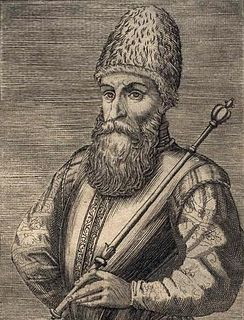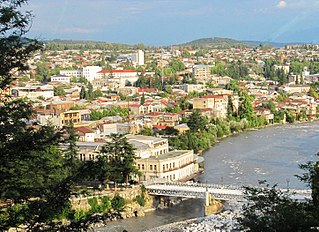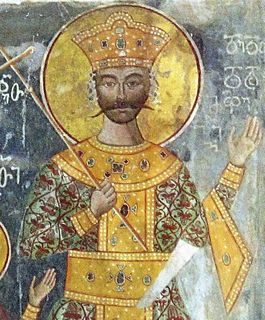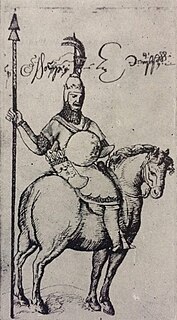Mamia IV Dadiani (Georgian :მამია IV დადიანი; died 1590) was Prince of Mingrelia, of the House of Dadiani, from 1573 to 1578 and again from 1582 until his death. He was a younger son of Levan I Dadiani.

Georgian is a Kartvelian language spoken by Georgians. It is the official language of Georgia. Georgian is written in its own writing system, the Georgian script. Georgian is the literary language for all regional subgroups of Georgians, including those who speak other Kartvelian languages: Svans, Mingrelians and the Laz.

The Principality of Mingrelia, also known as Odishi, was a historical state in Georgia ruled by the Dadiani dynasty. Established as an independent Principality in 1557 by Levan I Dadiani as a hereditary mtavari (Prince), it remained independent until it became subject to Imperial Russia in 1803. The principality ultimately came to an end when Prince Niko Dadiani was deposed, and the principality abolished, by Russia in 1867. Prince Niko officially renounced his rights to the throne in 1868.

The House of Dadiani was a Georgian family of nobles, dukes and princes, and a ruling dynasty of the western Georgian province of Samegrelo (Mingrelia) or Odishi.
Contents
Mamia Dadiani's career unfolded against the background of an increasingly destructive civil unrest in the successor states of the Kingdom of Georgia in which the rulers of Mingrelia, in the former kingdom's west, played a critical role. His first accession to power was the result of a coup against his own brother, Giorgi III Dadiani, with whom he eventually reconciled in exchange of new estates. His second term, after succeeding on the death of Giorgi III Dadiani, was consumed by wars with his in-laws, the prince of Guria and king of Imereti. The latter, Levan of Imereti, fell in Mamia's hands and died in captivity. Dadiani himself died without seeing his protégé firmly established on the throne of Imereti. He was succeeded by his younger brother, Manuchar I Dadiani.

The Kingdom of Georgia, also known as the Georgian Empire, was a medieval Eurasian monarchy which emerged circa 1008 AD. It reached its Golden Age of political and economic strength during the reign of King David IV and Queen Tamar the Great from 11th to 13th centuries. Georgia became one of the pre-eminent nations of the Christian East, her pan-Caucasian empire stretching, at its largest extent, from Eastern Europe and the North Caucasus to the northern portion of Iran and Anatolia, while also maintaining religious possessions abroad, such as the Monastery of the Cross in Jerusalem and the Monastery of Iviron in Greece. It was the principal historical precursor of present-day Georgia.
Giorgi III Dadiani was Prince of Mingrelia, of the House of Dadiani, from 1572 to 1573 and again from 1578 until his death. He was a son and successor of Levan I Dadiani.

The Principality of Guria was a historical state in Georgia. Centered on modern-day Guria, a southwestern region in Georgia, it was located between the Black Sea and Lesser Caucasus, and was ruled by a succession of twenty-two princes of the House of Gurieli from the 1460s to 1829. The principality emerged during the process of fragmentation of a unified Kingdom of Georgia. Its boundaries fluctuated in the course of permanent conflicts with neighboring Georgian rulers and Ottoman Empire, and the principality enjoyed various degrees of autonomy until being annexed by Imperial Russia in 1829.










